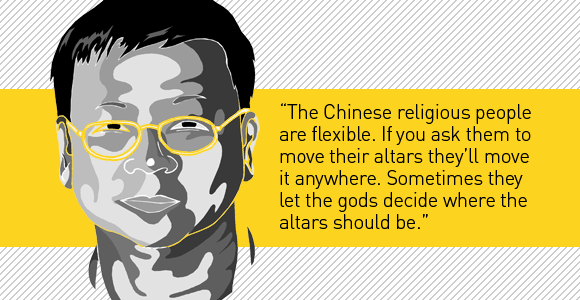Expert
Victor Yue
on how religion finds its own space in this modern city

Graphic by FIRDIANA FAWZIR
In 2004, Victor Yue pioneered the Taoism Singapore group, an online forum for the exchange of knowledge and experiences about local Chinese temples and Taoist heritage. It takes an anthropological approach in understanding Chinese roots and culture, and also plans trips to different temples and events. Yue believes that such research from a heritage perspective not only allows insights of our local origins, but also inevitably reveals Singapore’s relations with China and other countries like Malaysia and Indonesia. The group can be accessed at http://groups.yahoo.com/group/taoism-singapore.
Walking around Singapore, one finds small Chinese altars planted randomly on the streets and in kopitiams. Can you tell us more about these informal religious sites?
The history of setting up altars or temples came from our early migrants. They came from China to Singapore as coolies, so they didn’t have much education – they only had pure faith. Some of them even carried their statues all the way from their homelands to here because to them, these statues represented home. They believed that when you pray to a particular temple that you set up here, you’re effectively communicating back to your home. No telephones! These are things they did in the past that showed pure faith and a longing for their place of origin.
These days, people need a peace of mind. And just by putting a tua pek kong somewhere, there is a presence of peace. Religion is in the mind, but having a tua pek kong statue helps people to visualise. If you go to hotels, you will also see these altars. Chambermaids and other hotel staff work the late night shifts, so they need this peace of mind.
What’s the importance of having such religious spaces like altars and temples?
In the old days, temples were like community centres. When migrants arrived in Singapore that is the first place they would go to for prayers. They would also go there to look for jobs! At night, there would be many activities outside the temple such as storytelling and singing. That’s why a temple is called a miao hui, which means ‘gathering’. But all these are gone now. The only place where you can see this today is probably Waterloo Street.
What is the state’s role in these religious sites?
In the past, authorities were more sensitive to beliefs and these days, I guess not so much. But if you walk around now, how many temples do you see? Not many. And these temples are on a 30-year lease. You can renew the lease, but the government reserves the right not to extend it so you take the risk of planting it. There’s a temple at Tanjong Pagar near Amara Hotel that’s 102 years old. I understand that it’s now on temporary license and the land acquired is now used based on rental. However, the temple has a long history! It’s a Taoist temple built by a Buddhist monk and here in this temple, they conduct lots of ghost marriages. So all these temples have their own stories.
How do people decide where to place altars and what if it has to be moved?
The Chinese religious people are flexible. If you ask them to move their altars they’ll move it anywhere. Sometimes they let the gods decide where the altars should be. And they’re also very creative – anywhere they feel they should have an altar, they build it up. Sometimes it’s very simple, it can come from a dream. A Taoist may have a dream of instruction to build an altar or temple somewhere and then he’ll do it. And if you put a joss stick somewhere and someone comes along and sees it, it’s in his Chinese psyche to start praying. Just put a guan yin statue anywhere and he’ll pray to it. But this applies for those 60 years old and above, these days, the younger ones just walk away.
